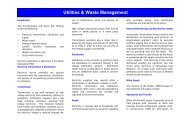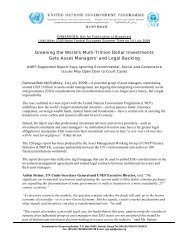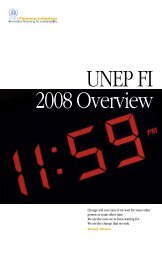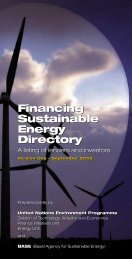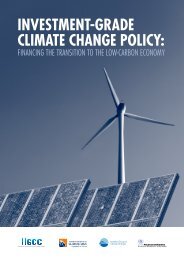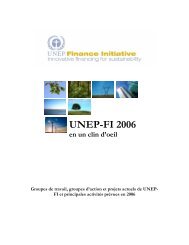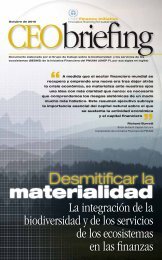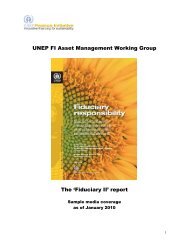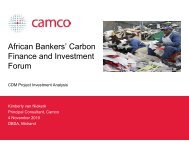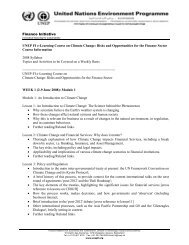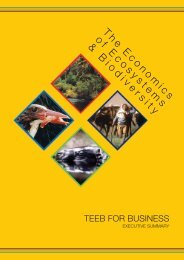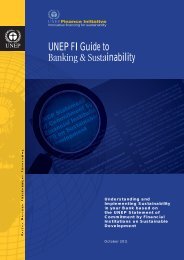Carbon 2009 Emission trading coming home - UNEP Finance Initiative
Carbon 2009 Emission trading coming home - UNEP Finance Initiative
Carbon 2009 Emission trading coming home - UNEP Finance Initiative
Create successful ePaper yourself
Turn your PDF publications into a flip-book with our unique Google optimized e-Paper software.
<strong>Carbon</strong> <strong>2009</strong><br />
1. Introduction<br />
The first Kyoto commitment<br />
period is now well under way.<br />
The US has a new administration<br />
committed to deep cuts<br />
in greenhouse gas (GHG)<br />
emissions. Across the pond, the<br />
EU is ironing out the final details<br />
of the bloc’s climate and energy<br />
policy blueprint toward 2020.<br />
Japan is discussing its mediumterm<br />
(2020) GHG target and<br />
Australia is working on its own<br />
emission <strong>trading</strong> scheme, due<br />
to launch in mid-2010. China,<br />
possibly the most crucial player<br />
in global climate negotiations<br />
to conclude later this year,<br />
remains the main host for clean<br />
development mechanism (CDM)<br />
projects.<br />
The world is also in the midst of a<br />
marked economic slowdown that,<br />
unusually, has hit most corners<br />
of the world simultaneously.<br />
This is clearly also being felt in<br />
the carbon market, in at least<br />
three ways. First, carbon prices<br />
are down from their highs in the<br />
summer of 2008, having dropped<br />
by two-thirds in several cases.<br />
Second, emissions in Kyoto’s<br />
capped Annex B countries are<br />
down, reducing demand for<br />
carbon credits. Third, finance for<br />
CDM and other credit projects is<br />
harder to receive amid the credit<br />
crunch as banks cut down on<br />
lending.<br />
Against this backdrop, we<br />
present our fourth annual report<br />
on the global carbon market. We<br />
seek to provide a comprehensive<br />
overview of all mandatory GHG<br />
emission <strong>trading</strong> schemes,<br />
whether current or up<strong>coming</strong>.<br />
Our main data source is our annual<br />
<strong>Carbon</strong> Market Survey, but we<br />
also draw on Point <strong>Carbon</strong>’s indepth<br />
analyses of global carbon<br />
markets and international climate<br />
policy in our publication series:<br />
<strong>Carbon</strong> Market Analyst (CMA),<br />
<strong>Carbon</strong> Market Monitor (CMM),<br />
<strong>Carbon</strong> Market Brief (CMB) and<br />
<strong>Carbon</strong> Policy Update (CPU).<br />
Furthermore, data from Point<br />
<strong>Carbon</strong>’s proprietary databases,<br />
models and applications have<br />
been consulted, specifically<br />
<strong>Carbon</strong> Market Trader (CMT) and<br />
<strong>Carbon</strong> Project Manager (CPM).<br />
1,394 of 3,319<br />
respondents involved<br />
in carbon <strong>trading</strong><br />
The survey ran from 20 January<br />
to 15 February, and garnered a<br />
total of 3,319 responses using<br />
a web-based survey tool. In<br />
the years from 2006 to 2008,<br />
by comparison, our survey had<br />
800, 2,250 and 3,703 replies,<br />
respectively. Of this year’s<br />
respondents, 88 percent were<br />
invited directly by e-mail whereas<br />
the remaining 12 percent found<br />
their way to the survey using a<br />
web link on Point <strong>Carbon</strong>’s <strong>home</strong><br />
page. In total, the survey had a<br />
response rate of eight percent,<br />
comparing actual responses to<br />
the number of invitations or web<br />
site visits.<br />
Among the respondents, 1,394<br />
stated that they were involved<br />
in <strong>trading</strong> various compliance<br />
carbon allowances and credits, or<br />
owned such carbon instruments.<br />
In this group, the largest subset<br />
comprises clean development<br />
mechanism (CDM) project<br />
developers, aggregators and<br />
others involved in the primary<br />
CDM market – these make up<br />
450 of the respondents. Second<br />
are companies with emissions<br />
regulated under the EU emission<br />
<strong>trading</strong> scheme (EU ETS), counting<br />
385 respondents.<br />
Financial institutions, including<br />
banks, come in third at 220. Other<br />
groups are offset developers in<br />
the North American market (53),<br />
Joint Implementation (JI) project<br />
developers (44), governments<br />
(38), companies covered by CO 2<br />
regulation other than the EU<br />
ETS or the Regional Greenhouse<br />
Gas <strong>Initiative</strong> (RGGI, 27) and<br />
companies regulated by RGGI<br />
(11).<br />
Figure 1.1 shows the distribution<br />
of respondents among this<br />
subset, compared to last year.<br />
Note that CDM developers/<br />
aggregators have surpassed EU<br />
ETS companies as the largest<br />
group in this year’s survey.<br />
Our typical respondent has a<br />
degree in either engineering<br />
or finance/economics, while<br />
14 percent hold a PhD. Twothirds<br />
are between the ages of<br />
25 and 44. The largest number<br />
of respondents is found in the<br />
US (see Figure 1.2) — a total<br />
of 482 (up from 292 last year);<br />
the other countries with threedigit<br />
response totals are the<br />
UK (354), India (145), Germany<br />
(135), Australia (114) and Canada<br />
(112). In total, 116 countries<br />
are represented, according to<br />
respondents’ self-reporting.<br />
It should be noted that this survey<br />
is taken among individuals that<br />
tend to be more than average<br />
interested in carbon <strong>trading</strong> and<br />
climate policy. Furthermore,<br />
since taking the survey is based<br />
in part on individual motivation,<br />
the sampling of various subsets<br />
of the carbon community is less<br />
than scientific. All interpretations<br />
of the survey should therefore<br />
be read bearing in mind that the<br />
1<br />
All rights reserved © <strong>2009</strong> Point <strong>Carbon</strong>



